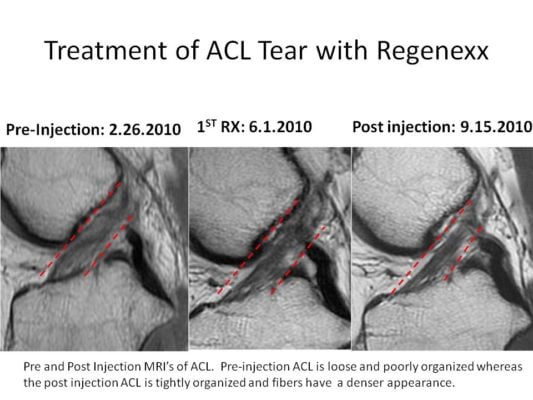Treatment of Loose and Stretched ACL with Stem Cell Injection
These are before/after images of a patient treated with a pre-injection and then cultured stem cells into the ACL. The ACL is the major stabilizer of the knee in the front back direction. The ACL can be torn partially (like in this case stretched with small tears but not pulled apart) or torn completely and retracted with the pieces no longer connected (retracted). Repairing the ACL surgically doesn’t seem to be able to prevent the appearance of arthritis, perhaps due to the repair tissue not being like the real tissue. We have shown that prolotherapy for the ACL can result in improvement with a partial tear of the ligament.

EK is a 31 y/o athletic officer at one of the nation’s military academies who sustained a partial tear in his ACL ligament. Instead of having the ACL removed surgically and replaced, he opted for a non-surgical injection therapy consisting of a pre-injection with prolotherapy and then injection of his own stem cells into the partially torn ACL ligament. MRI’s of the knee are above. The patient reported significant improvement which corresponded with the improvement seen on MRI. In the pre-injection MRI (far left), the ACL is loosely organized (looks like a bunch of strings that aren’t tight) whereas after prolotherapy (middle) and stem cell therapy (right) utilizing the Regenexx procedure, the ACL is tightly organized and the fibers have a denser and more normal appearance. The ACL is identified with dashed red line.
Here are EK’s comments post injection:
“Yes, my knee feels stronger and more stable in day to day, hiking, running, biking and swimming activities. I went hiking last weekend with a light overnight backpack on a steep trail. In loose rock and during slight mis-steps, my knee remained stable. I did do some activity tests at the clinic and the chiropracter noted less sharpness on certain resistance motions with my right leg as compared to my left leg. Considering, I heard a pop and couldn’t walk normally for over two months, I’m happy with the improvements my knee has shown. Stability has improved and mentally I am willing to trust it’s strength. My PT agreed there was no longer any reason for me to pursue surgery any more. ”

NOTE: This blog post provides general information to help the reader better understand regenerative medicine, musculoskeletal health, and related subjects. All content provided in this blog, website, or any linked materials, including text, graphics, images, patient profiles, outcomes, and information, are not intended and should not be considered or used as a substitute for medical advice, diagnosis, or treatment. Please always consult with a professional and certified healthcare provider to discuss if a treatment is right for you.
